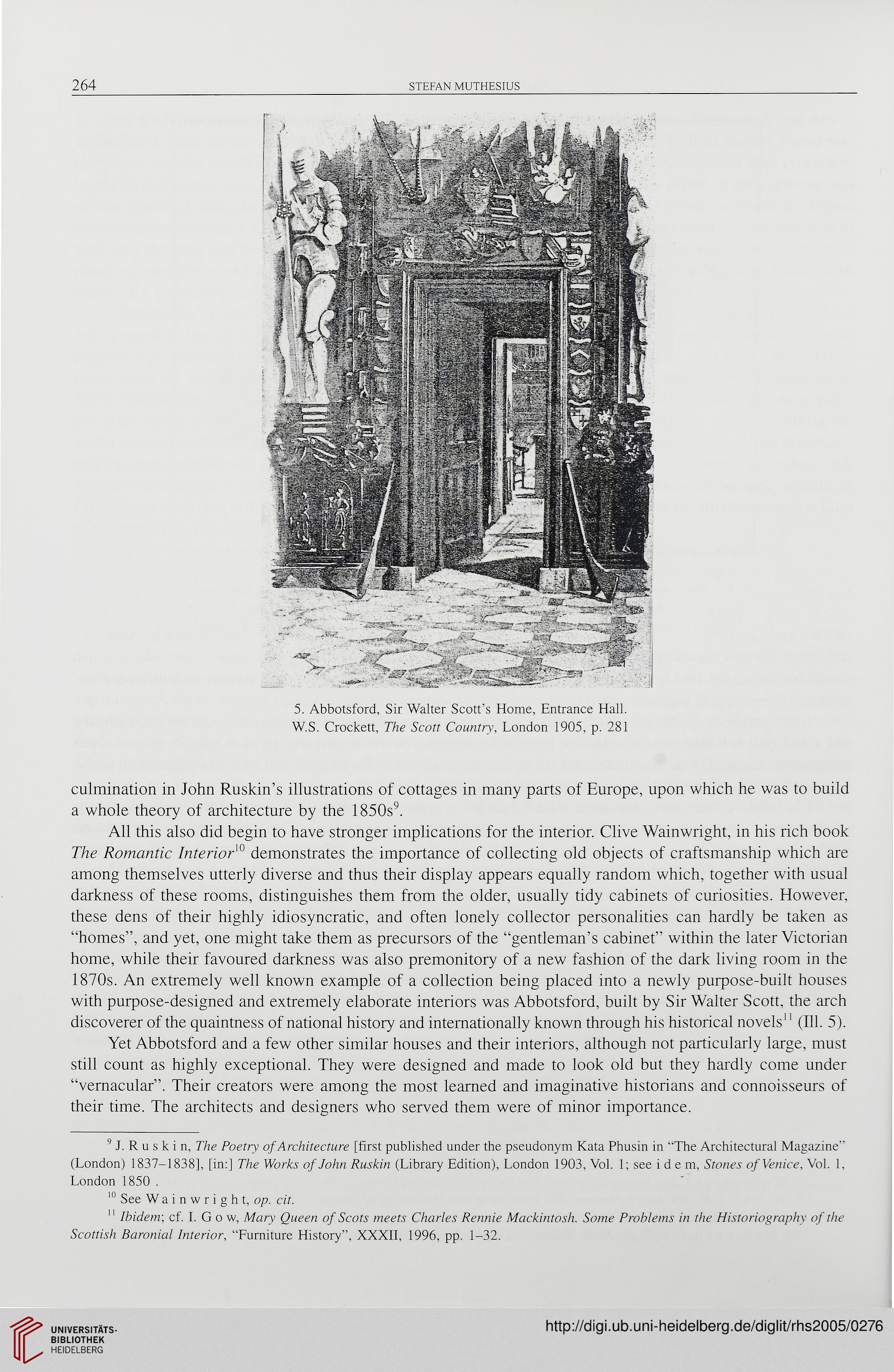264
STEFAN MUTHESIUS
5. Abbotsford, Sir Walter Scott's Home, Entrance Hall.
W.S. Crockett, The Scott Country; London 1905, p. 281
culmination in John Ruskin's illustrations of cottages in many parts of Europe, upon which he was to build
a whole theory of architecture by the 1850s9.
Ali this also did begin to have stronger implications for the interior. Clive Wainwright, in his rich book
The Romantic Interior*0 demonstrates the importance of collecting old objects of craftsmanship which are
among themselves utterly diverse and thus their display appears equally random which, together with usual
darkness of thèse rooms, distinguishes them from the older, usually tidy cabinets of curiosities. However,
thèse dens of their highly idiosyncratic, and often lonely collector personalities can hardly be taken as
"homes", and yet, one might take them as precursors of the "gentleman's cabinet" within the later Victorian
home, while their favoured darkness was also premonitory of a new fashion of the dark living room in the
1870s. An extremely well known example of a collection being placed into a newly purpose-built houses
with purpose-designed and extremely elaborate interiors was Abbotsford, built by Sir Walter Scott, the arch
discoverer of the quaintness of national history and internationally known through his historical novels11 (Ш. 5).
Yet Abbotsford and a few other similar houses and their interiors, although not particularly large, must
still count as highly exceptional. They were designed and made to look old but they hardly come under
"vernacular". Their creators were among the most learned and imaginative historians and connoisseurs of
their time. The architects and designers who served them were of minor importance.
9 J. R u s к i n, The Poetry of Architecture [first published under the pseudonym Kata Phusin in "The Architectural Magazine"
(London) 1837-1838], [in:] The Works of John Ruskin (Library Edition), London 1903, Vol. 1; see i d e m, Stones ofVenice. Vol. 1,
London 1850 .
10 See Wainwright, op. cit.
" Ibidem; cf. I. G o w, Mary Queen of Scots meets Charles Rennie Mackintosh. Some Problems in the Historiography of the
Scottish Baronial Interior, "Furniture History", XXXII, 1996, pp. 1-32.
STEFAN MUTHESIUS
5. Abbotsford, Sir Walter Scott's Home, Entrance Hall.
W.S. Crockett, The Scott Country; London 1905, p. 281
culmination in John Ruskin's illustrations of cottages in many parts of Europe, upon which he was to build
a whole theory of architecture by the 1850s9.
Ali this also did begin to have stronger implications for the interior. Clive Wainwright, in his rich book
The Romantic Interior*0 demonstrates the importance of collecting old objects of craftsmanship which are
among themselves utterly diverse and thus their display appears equally random which, together with usual
darkness of thèse rooms, distinguishes them from the older, usually tidy cabinets of curiosities. However,
thèse dens of their highly idiosyncratic, and often lonely collector personalities can hardly be taken as
"homes", and yet, one might take them as precursors of the "gentleman's cabinet" within the later Victorian
home, while their favoured darkness was also premonitory of a new fashion of the dark living room in the
1870s. An extremely well known example of a collection being placed into a newly purpose-built houses
with purpose-designed and extremely elaborate interiors was Abbotsford, built by Sir Walter Scott, the arch
discoverer of the quaintness of national history and internationally known through his historical novels11 (Ш. 5).
Yet Abbotsford and a few other similar houses and their interiors, although not particularly large, must
still count as highly exceptional. They were designed and made to look old but they hardly come under
"vernacular". Their creators were among the most learned and imaginative historians and connoisseurs of
their time. The architects and designers who served them were of minor importance.
9 J. R u s к i n, The Poetry of Architecture [first published under the pseudonym Kata Phusin in "The Architectural Magazine"
(London) 1837-1838], [in:] The Works of John Ruskin (Library Edition), London 1903, Vol. 1; see i d e m, Stones ofVenice. Vol. 1,
London 1850 .
10 See Wainwright, op. cit.
" Ibidem; cf. I. G o w, Mary Queen of Scots meets Charles Rennie Mackintosh. Some Problems in the Historiography of the
Scottish Baronial Interior, "Furniture History", XXXII, 1996, pp. 1-32.




